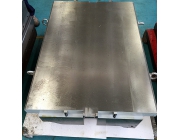after the workpiece is machined, there is residual stress on the surface layer. The residual compressive stress can increase the wear resistance of the workpiece surface and the fatigue strength when it is subjected to tensile stress, and the effect of residual tensile stress is just the opposite. When the tensile stress value exceeds the fatigue strength limit of workpiece material, cracks will appear on the surface of workpiece and accelerate the damage of workpiece. The causes of residual stress include the following three aspects:

(1) residual stress caused by cold plastic deformation
under the action of cutting force, the machined surface is subjected to strong cold plastic deformation, in which the plastic deformation of the tool knives facing the extrusion and friction of the machined surface is the most prominent. At this time, the matrix metal is affected in the elastic deformation state. After the cutting force is removed, the matrix metal tends to recover, but it is limited by the surface layer that has produced plastic deformation and is not restored to the original shape. Therefore, the residual compressive stress is produced in the surface layer.
(2) residual stress induced by thermoplastic deformation
the machined surface of the workpiece produces thermal expansion under the action of cutting heat, when the temperature of the base metal is low, so the surface metal generates hot compressive stress. When the cutting process ends, the surface temperature drops rapidly, so the shrinkage deformation is larger than the inner layer, and the residual tensile stress is generated because the surface deformation is restricted by the matrix metal. The higher the cutting temperature, the greater the plastic deformation, the greater the residual tensile stress, and sometimes even the crack. The thermal plastic deformation produced in grinding is more obvious.
(3) residual stress induced by metallographic structure change
the high temperature produced during cutting will lead to the change of metallographic structure of the surface layer. Different metallographic structures have different densities. The change of the microstructure of the surface layer results in the volume change. When the volume of the surface layer expands, the compressive stress is produced because of the limitation of the matrix, whereas on the contrary, the tensile stress is generated.



















 (1) residual stress caused by cold plastic deformation
(1) residual stress caused by cold plastic deformation 